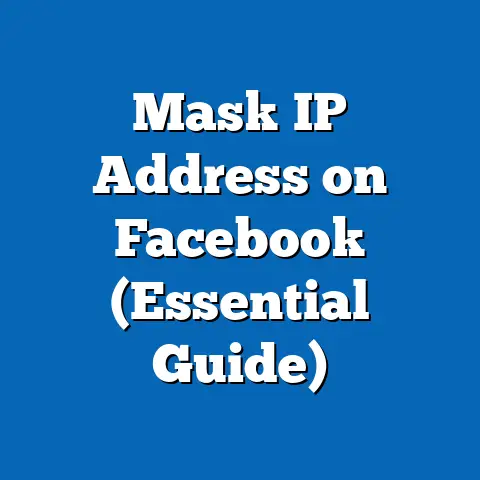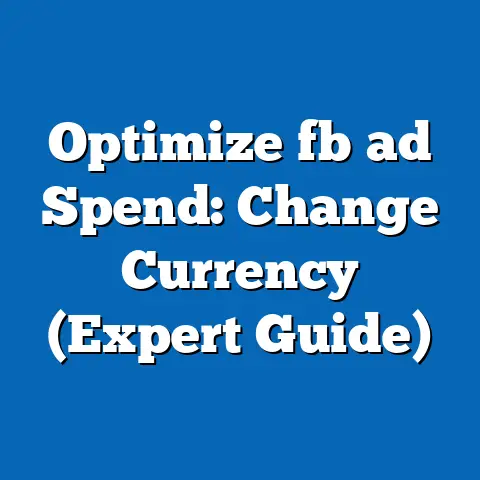How to Access Facebook Ads Invoice (Essential Guide)
The digital advertising landscape is a battlefield. Businesses march into the fray, armed with creative campaigns and targeting strategies, hoping to capture the attention of potential customers. Facebook Ads, in particular, has become a pivotal weapon in this arsenal, offering unparalleled reach and precision targeting. But just like any powerful tool, Facebook Ads requires careful management, especially when it comes to finances.
Imagine launching a brilliant campaign, seeing your website traffic surge, and leads pouring in. You’re riding high, convinced you’ve cracked the code to online success. Then, the bill arrives. A hefty sum, far exceeding your initial expectations. Panic sets in. Where did all that money go? Was the campaign really as effective as you thought?
This is where understanding and accessing your Facebook Ads invoices becomes absolutely crucial. It’s not just about paying the bill; it’s about gaining insights into your ad performance, optimizing your spending, and ensuring your marketing efforts are actually driving a positive return on investment (ROI).
Section 1: The Importance of Facebook Ads Invoices
Think of your Facebook Ads invoices as more than just bills; they’re detailed reports on how your advertising budget is being utilized. They offer a level of transparency that’s essential for any business, regardless of size. Let’s explore why these invoices are so vital.
Financial Transparency and Budgeting
Invoices are the cornerstone of financial transparency. They provide a clear record of your advertising expenses, allowing you to track where your money is going. This is especially important for businesses with strict budgets. Without invoices, it’s like trying to navigate a maze blindfolded. You might eventually find your way, but you’ll likely stumble and waste resources along the way.
For instance, imagine you’re running multiple ad campaigns simultaneously. Without invoices, it’s difficult to pinpoint which campaigns are driving the most conversions and which are simply burning through your budget. Invoices break down your spending by campaign, ad set, and even individual ads, giving you a granular view of your performance.
I’ve personally seen businesses save thousands of dollars simply by paying closer attention to their invoices. They identified underperforming campaigns, reallocated their budget to more effective strategies, and saw a significant increase in their ROI.
Ad Performance Insights
Beyond just tracking expenses, invoices can also provide valuable insights into your ad performance. By analyzing the data in your invoices, you can identify trends, understand your customer acquisition cost (CAC), and optimize your campaigns for better results.
For example, if you notice a sudden spike in your ad spend without a corresponding increase in conversions, it could indicate a problem with your targeting or ad creative. Perhaps your target audience is too broad, or your ad copy isn’t resonating with your audience. By examining your invoices in conjunction with your other analytics data, you can identify these issues and take corrective action.
I remember working with a client who was struggling to generate leads through Facebook Ads. After reviewing their invoices, I noticed that they were spending a significant amount of money on mobile placements, but their conversion rate on mobile was much lower than on desktop. We decided to reduce their mobile bid and increase their desktop bid, and their lead generation immediately improved.
Avoiding Overspending and Misallocation of Resources
One of the biggest dangers of not monitoring your ad spend through invoices is the risk of overspending and misallocation of resources. It’s easy to get caught up in the excitement of running ads and lose track of your budget. Invoices serve as a crucial checkpoint, helping you stay within your financial limits and ensure your money is being used effectively.
Imagine you’ve set a daily budget of $50 for your ad campaign. Without regularly checking your invoices, you might not realize that your campaign is actually spending $75 per day. Over time, this can quickly add up, leading to significant overspending.
I once encountered a business owner who had accidentally set their daily budget to $500 instead of $50. They didn’t realize their mistake until they received a massive invoice at the end of the month. The consequences were severe, impacting their cash flow and forcing them to cut back on other essential expenses.
Key Takeaway: Facebook Ads invoices are not just bills; they’re essential tools for financial transparency, ad performance insights, and avoiding overspending. Regularly accessing and analyzing your invoices is crucial for maximizing your ROI and achieving your marketing goals.
Section 2: Understanding Facebook Ads Billing
Before you can effectively access and analyze your Facebook Ads invoices, it’s essential to understand how Facebook Ads billing works. Let’s break down the key aspects.
Billing Cycles
Facebook Ads billing cycles typically occur when you reach your billing threshold or at the end of the month, whichever comes first. Your billing threshold is a predetermined amount that triggers a charge to your payment method. Facebook sets this threshold based on your initial spending and gradually increases it as you consistently pay your bills on time.
For example, if your billing threshold is $25, Facebook will charge your payment method every time your ad spend reaches $25. If you don’t reach your threshold by the end of the month, Facebook will charge you for your total ad spend at the end of the month.
It’s important to be aware of your billing threshold and monitor your ad spend accordingly. If you’re running a large campaign, you might reach your threshold multiple times per day, resulting in frequent charges to your payment method.
Payment Methods
Facebook accepts a variety of payment methods, including credit cards, debit cards, PayPal, and local payment options depending on your region. It’s important to choose a payment method that’s convenient for you and allows you to track your expenses effectively.
I recommend using a credit card that offers rewards points or cashback. This can help you offset some of your advertising costs and earn additional benefits.
Currency Considerations
If you’re advertising in a different country than your business is based in, you’ll need to consider currency exchange rates. Facebook allows you to choose your preferred currency when setting up your ad account. However, it’s important to be aware that exchange rates can fluctuate, which can impact your actual ad spend.
I advise regularly monitoring exchange rates and adjusting your budget accordingly. You can also consider using a credit card or payment method that offers favorable exchange rates.
Ad Spend vs. Invoice Amounts
It’s important to understand the difference between your ad spend and the actual amount you’re charged on your invoices. Your ad spend is the total amount you’ve spent on your ads during a specific period. However, the amount you’re charged on your invoices may be slightly different due to factors such as taxes, discounts, and currency exchange rates.
Always review your invoices carefully to ensure that the charges are accurate and reflect your actual ad spend. If you notice any discrepancies, contact Facebook support immediately.
Types of Charges
Your Facebook Ads invoices may include various types of charges, including:
- Click-Through Charges: These are charges for each time someone clicks on your ad.
- Impression Charges: These are charges for each time your ad is displayed to someone.
- Conversion Charges: These are charges for each time someone takes a desired action after seeing your ad, such as making a purchase or filling out a form.
- Additional Fees: These may include taxes, currency exchange fees, or other charges.
Understanding the different types of charges on your invoices is crucial for analyzing your ad performance and optimizing your spending.
How Facebook Calculates Charges
Facebook calculates charges based on your ad campaigns and budgets. You can set a daily or lifetime budget for each campaign, and Facebook will automatically adjust your bids to stay within your budget.
Facebook uses an auction system to determine which ads are displayed to users. The ads with the highest bids and the most relevant content are more likely to be shown. Therefore, it’s important to carefully consider your bidding strategy and target audience to maximize your chances of success.
Key Takeaway: Understanding Facebook Ads billing is crucial for managing your advertising expenses effectively. Be aware of your billing cycles, payment methods, currency considerations, and the different types of charges on your invoices. This knowledge will empower you to make informed decisions about your ad spending and optimize your campaigns for better results.
Section 3: Step-by-Step Guide to Accessing Your Facebook Ads Invoice
Now that you understand the basics of Facebook Ads billing, let’s dive into the step-by-step process of accessing your invoices.
Step 1: Logging into Facebook Ads Manager
First, you’ll need to log into your Facebook Ads Manager account. You can do this by going to https://www.facebook.com/adsmanager and entering your Facebook login credentials.
If you have multiple ad accounts, make sure you select the correct one from the dropdown menu in the top left corner.
Step 2: Navigating to the ‘Billing’ Section
Once you’re logged into your Ads Manager account, click on the three horizontal lines in the top left corner to open the main menu. Then, scroll down and select ‘Billing’.
This will take you to the Billing section, where you can view your payment history, manage your payment methods, and access your invoices.
Step 3: Selecting the Appropriate Date Range for Invoices
In the Billing section, you’ll see a dropdown menu labeled ‘Date Range’. Use this menu to select the date range for the invoices you want to view.
You can choose from predefined date ranges such as ‘Last Month’, ‘This Month’, or ‘Last 3 Months’, or you can select a custom date range by clicking on ‘Custom’.
Step 4: Locating Specific Invoices and Understanding Their Layout
Once you’ve selected your date range, you’ll see a list of your transactions, including payments, charges, and adjustments. To view a specific invoice, click on the transaction ID.
This will open a detailed view of the invoice, including the invoice number, date, payment method, and a breakdown of the charges.
The invoice layout typically includes the following sections:
- Header: This section contains the invoice number, date, and your business information.
- Payment Method: This section shows the payment method used for the transaction.
- Summary: This section provides a summary of the charges, including the total amount spent, taxes, and discounts.
- Details: This section provides a detailed breakdown of the charges, including the campaign name, ad set name, and individual ad name.
Step 5: Downloading Invoices for Record-Keeping
To download an invoice for your records, click on the ‘Download’ button in the top right corner of the invoice view.
You can choose to download the invoice in PDF or CSV format. PDF format is ideal for viewing and printing, while CSV format is useful for importing the data into a spreadsheet or accounting software.
Common Issues and Troubleshooting
Sometimes, users encounter issues while trying to access their Facebook Ads invoices. Here are some common problems and how to troubleshoot them:
- Problem: Can’t find the ‘Billing’ section in Ads Manager.
- Solution: Make sure you’re logged into the correct ad account. Also, ensure you have the necessary permissions to access the Billing section.
- Problem: Invoices are missing for a specific date range.
- Solution: Double-check the date range you’ve selected. Also, make sure your ad campaigns were active during that period.
- Problem: Can’t download invoices.
- Solution: Try clearing your browser cache and cookies. Also, try using a different browser or device.
- Solution: Make sure you’re logged into the correct ad account. Also, ensure you have the necessary permissions to access the Billing section.
- Solution: Double-check the date range you’ve selected. Also, make sure your ad campaigns were active during that period.
- Solution: Try clearing your browser cache and cookies. Also, try using a different browser or device.
If you’re still having trouble accessing your invoices, contact Facebook support for assistance.
Key Takeaway: Accessing your Facebook Ads invoices is a straightforward process. By following these step-by-step instructions, you can easily locate, view, and download your invoices for record-keeping and analysis. Don’t hesitate to contact Facebook support if you encounter any issues.
Section 4: Analyzing Facebook Ads Invoices
Accessing your invoices is only the first step. The real value lies in analyzing the data they contain to gain insights into your ad performance and optimize your spending. Let’s explore how to interpret the information presented in your invoices.
Key Terms and Sections
Familiarize yourself with the key terms and sections of your Facebook Ads invoices:
- Invoice Number: A unique identifier for each invoice.
- Invoice Date: The date the invoice was issued.
- Billing Period: The date range covered by the invoice.
- Account Name: The name of your Facebook ad account.
- Payment Method: The payment method used for the transaction.
- Total Spent: The total amount spent on ads during the billing period.
- Taxes: The amount of taxes charged on your ad spend.
- Discounts: Any discounts applied to your ad spend.
- Adjustments: Any adjustments made to your ad spend, such as refunds or credits.
- Campaign Name: The name of the ad campaign.
- Ad Set Name: The name of the ad set.
- Ad Name: The name of the individual ad.
- Impressions: The number of times your ad was displayed.
- Clicks: The number of times people clicked on your ad.
- Cost Per Click (CPC): The average cost of each click on your ad.
- Conversions: The number of desired actions taken after seeing your ad.
- Cost Per Conversion (CPC): The average cost of each conversion.
Understanding these terms and sections will enable you to effectively analyze your invoices and extract valuable insights.
Comparing Invoices Over Time
One of the most effective ways to analyze your Facebook Ads invoices is to compare them over time. This allows you to identify trends, track your spending, and assess the effectiveness of your ad campaigns.
For example, if you notice a consistent increase in your ad spend without a corresponding increase in conversions, it could indicate a problem with your targeting or ad creative. Perhaps your target audience is becoming saturated, or your ad copy is losing its effectiveness.
By comparing your invoices over time, you can also identify seasonal trends and adjust your budget accordingly. For instance, if you notice a significant increase in conversions during the holiday season, you might want to increase your ad spend during that period.
Extracting Actionable Insights
The ultimate goal of analyzing your Facebook Ads invoices is to extract actionable insights that can inform your marketing strategies. Here are some examples of how you can use your invoices to improve your ad performance:
- Identify Underperforming Campaigns: If you notice that certain campaigns are consistently generating low conversions, consider pausing or optimizing them.
- Optimize Targeting: If you notice that certain demographics or interests are generating higher conversions, focus your targeting on those groups.
- Refine Ad Creative: If you notice that certain ad creatives are generating higher click-through rates, use them as inspiration for future ads.
- Adjust Bidding Strategy: If you notice that your CPC is too high, consider lowering your bids or optimizing your ad quality score.
- Reallocate Budget: If you notice that certain campaigns are generating a higher ROI, reallocate your budget to those campaigns.
By analyzing your invoices and extracting actionable insights, you can continuously improve your ad performance and maximize your ROI.
Key Takeaway: Analyzing your Facebook Ads invoices is crucial for gaining insights into your ad performance and optimizing your spending. Familiarize yourself with the key terms and sections of your invoices, compare them over time, and extract actionable insights that can inform your marketing strategies.
Section 5: Best Practices for Managing Facebook Ads Invoices
Managing your Facebook Ads invoices effectively is crucial for maintaining financial control and maximizing your ROI. Let’s explore some best practices for keeping track of your invoices, auditing your expenses, and communicating with stakeholders.
Keeping Track of Invoices and Ad Spend
Establish a system for keeping track of your Facebook Ads invoices and ad spend. This could involve creating a spreadsheet, using accounting software, or utilizing a dedicated invoice management tool.
I recommend creating a folder on your computer or in the cloud where you can store all of your invoices. Name the folder something descriptive, such as “Facebook Ads Invoices,” and organize the invoices by month and year.
You can also use a spreadsheet to track your ad spend, including the date, invoice number, campaign name, and total amount spent. This will allow you to quickly see how much you’re spending on Facebook Ads each month and identify any potential issues.
Regular Audits of Advertising Expenses
Conduct regular audits of your advertising expenses to ensure that your spending is aligned with your goals and that you’re not wasting money on underperforming campaigns.
Schedule a monthly or quarterly audit of your Facebook Ads invoices. During the audit, review your invoices carefully to identify any discrepancies or anomalies. Compare your ad spend to your conversion rates and ROI to assess the effectiveness of your campaigns.
If you notice any issues, take corrective action immediately. This could involve pausing or optimizing underperforming campaigns, refining your targeting, or adjusting your bidding strategy.
Tools and Software for Invoice Management
Consider using tools and software to assist with managing your invoices, budgeting, and reporting. There are many options available, ranging from free spreadsheet templates to sophisticated accounting software.
Some popular invoice management tools include:
- Zoho Invoice: A free and easy-to-use invoice management tool that allows you to create, send, and track invoices.
- FreshBooks: A cloud-based accounting software that offers invoice management, expense tracking, and reporting features.
- Xero: Another cloud-based accounting software that offers similar features to FreshBooks.
These tools can help you automate your invoice management process, track your expenses, and generate reports.
Communicating Invoice Information with Stakeholders
Communicate invoice-related information with stakeholders or team members effectively. This could involve sharing your invoices, providing regular reports, or discussing your ad spend during team meetings.
If you’re working with a marketing agency, make sure they provide you with regular reports on your ad spend and performance. Discuss your invoices with them and ask them to explain any discrepancies or anomalies.
If you’re managing your Facebook Ads campaigns in-house, share your invoices and reports with your team members. This will help them understand the financial side of your advertising efforts and make informed decisions about their campaigns.
Key Takeaway: Managing your Facebook Ads invoices effectively is crucial for maintaining financial control and maximizing your ROI. Keep track of your invoices and ad spend, conduct regular audits of your expenses, use tools and software to assist with invoice management, and communicate invoice information with stakeholders.
Conclusion
Navigating the world of Facebook advertising can feel like a high-wire act, balancing creativity with data, strategy with execution, and, most importantly, results with budget. While the allure of captivating ads and laser-targeted campaigns is undeniable, true mastery lies in understanding and managing the financial aspect – and that starts with mastering your Facebook Ads invoices.
I’ve seen firsthand how a keen eye on invoices can transform a struggling campaign into a roaring success. It’s not just about paying the bill; it’s about unlocking the secrets hidden within the data, identifying opportunities for optimization, and ensuring every dollar spent is contributing to your bottom line.
So, take control of your Facebook advertising expenditures. Transform the often-daunting task of invoice management into an empowering practice that drives business success. Embrace the power of financial transparency, and let your invoices guide you toward a more profitable and sustainable future in the ever-evolving landscape of digital advertising. The key to unlocking your advertising potential is in your hands – now, go forth and conquer!






